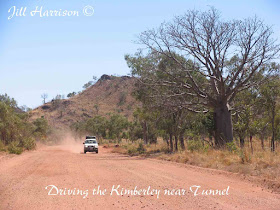The Gibb River Road is hot and dusty – they call it “bull dust”. It swirls around and is so fine it seeps into your car, up your nose and into your mouth. You can taste it. The first part of the road coming from Kununurra is grey dust, so fine it has the colour and taste of cement dust. When a vehicle passes the dust swirls around in a cloud so thick you can’t see one metre in front of you until the dust settles.
Later on the road turns to orange red dust and stretches straight ahead into the distance as far as you can see.
 Added to this are the corrugations. For those who don’t know what corrugations are – think of corrugated iron but change the substance to gravel and rock as hard as concrete and then imagine driving over it. It is a bone shaking experience that feels like it is trying to shake the car to pieces, everything rattles, including your bones.
Added to this are the corrugations. For those who don’t know what corrugations are – think of corrugated iron but change the substance to gravel and rock as hard as concrete and then imagine driving over it. It is a bone shaking experience that feels like it is trying to shake the car to pieces, everything rattles, including your bones.
There are also gullies and potholes that loom up in front of you, and the possibility of spiking a tyre on the sharp rocks that the grader has turned up. The condition of the road is dependant on when it was last graded so it can vary from very good to very bad. The best time to travel is from April to November, once the creek levels have dropped after the summer “wet” and it is recommended to carry two spare tyres, extra water, food and fuel.
 Why would anyone want to travel this dusty bone shaking road? Because “The Gibb” catches the imagination of travelers as it is one of the few remaining remote 4WD treks and the scenery and the gorges are spectacular.
Why would anyone want to travel this dusty bone shaking road? Because “The Gibb” catches the imagination of travelers as it is one of the few remaining remote 4WD treks and the scenery and the gorges are spectacular.
Originally built for large road trains transporting cattle from isolated stations to ports in Derby and Wyndham, the Gibb River Road, which is unsealed for most of its length, stretches 665km from just south of Derby to just west of Kununurra in Western Australia’s Kimberley.
Travelling from Kununurra the turn off onto the Gibb is 53 kilometers from Kununurra on the Great Northern Highway. The best way to experience the road is to travel from gorge to gorge camping overnight in bush camps along the way. You can swim at most of the gorges and camp nearby – both a welcome relief from the road conditions and the heat. The waterfalls are at their best early in the season.
Click on the boab photo opposite (World is Round - Western Australian images) and go to my link in "World is Round" to see some more photos.
This full article can be read in "On the Road" magazine, February 2010 edition.


No comments:
Post a Comment
I hope you have enjoyed your visit to my blog. Thank you for stopping by and for taking the time to comment. I read and very much appreciate every comment and love hearing from you. I will try to visit your blogs in return.